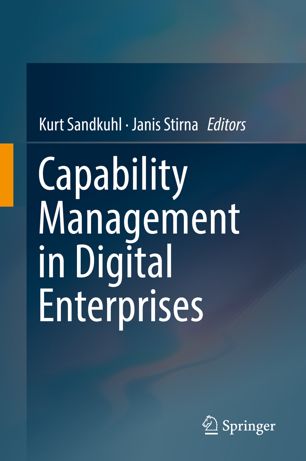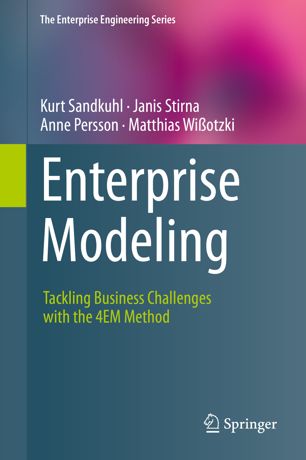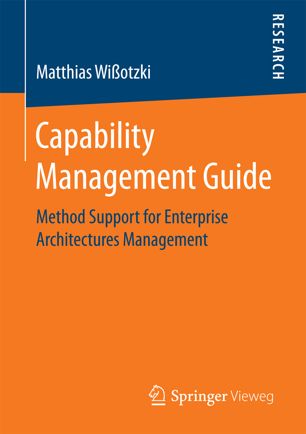Capability Management in Digital Enterprises
Kurt Sandkuhl, Janis Stirna
Putting capability management into practice requires both a solid theoretical foundation and realistic approaches. This book introduces a development methodology that integrates business and information system development and run-time adjustment based on the concept of capability by presenting the main findings of the CaaS project – the Capability-Driven Development (CDD) methodology, the architecture and components of the CDD environment, examples of real-world applications of CDD, and aspects of CDD usage for creating business value and new opportunities.
Capability thinking characterizes an organizational mindset, putting capabilities at the center of the business model and information systems development. It is expected to help organizations and in particular digital enterprises to increase flexibility and agility in adapting to changes in their economic and regulatory environments. Capability management denotes the principles of how capability thinking should be implemented in an organization and the organizational means.
This book is intended for anyone who wants to explore the opportunities for developing and managing context-dependent business capabilities and the supporting business services. It does not require a detailed understanding of specific development methods and tools, although some background knowledge and experience in information system development is advisable. The individual chapters have been written by leading researchers in the field of information systems development, enterprise modeling and capability management, as well as practitioners and industrial experts from these fields.
Keywords: Enterprise Modeling, Variability Management, Enterprise Information Systems, Model-driven Software Engineering, Enterprise Architecture
DOI: https://doi.org/10.1007/978-3-319-90424-5
Print-ISBN: 978-3-319-90423-8
Verlag: Springer International Publishing AG, part of Springer Nature 2018
Enterprise Modeling - Tackling Business Challenges with the 4EM Method
Kurt Sandkuhl, Janis Stirna, Anne Persson, Matthias Wißotzki
Enterprise modeling (EM) methods and techniques are indispensable for understanding the present situation of an enterprise and for preparing for its future – particularly in times of continuous organizational change, an increasing pace of innovation, new market challenges, or technology advances.
The authors combine a detailed description of the 4EM methodology with their concrete experience gathered in projects. Their book addresses the modeling procedure, modeling language and modeling practices in a uniquely integrated approach. It provides practical advice on common challenges faced by enterprises and offers a flexible EM method suitable for tackling those challenges. Much of the work presented stems from actual research projects and has been validated with scientific methods. The 4EM methodology has proven its practical value in a large number of successful development and/or change management projects in industry and the public sector.
The book was written for anyone who wants to learn more about EM, with a specific focus on how to do it in practice and/or how to teach it. Its main target audience thus includes instructors in the field of EM or business information systems, students in Information Systems or Business Administration, and practitioners working in enterprise or change management. The authors describe a clear reading path for each of these audiences, and complement the work with a set of slides and further teaching material available under www.4em-method.com.
Keywords: 4EM, ARIS, Archimate, DEMO, Enterprise Architecture, Enterprise Information Systems, Enterprise Modeling, Project Management, TOGAF, Zachman
DOI: https://doi.org/10.1007/978-3-662-43725-4
Print-ISBN: 978-3-662-43724-7
Verlag: Springer-Verlag Berlin Heidelberg 2014
Unternehmensmodellierung - Grundlagen, Methode und Praktiken
Kurt Sandkuhl, Matthias Wißotzki, Janis Stirna
Bei der Unternehmensmodellierung wird das Ziel verfolgt, die wichtigsten Komponenten von Organisationen sowie deren Relationen zueinander in geeigneten Modellen abzubilden. Die Unternehmensmodellierung findet in der Praxis Verwendung bei einer Vielzahl strategischer und operativer Aufgaben in Unternehmen, u.a. bei der Aufnahme und Visualisierung der aktuellen Abläufe, Strukturen und Produkte sowie deren Zusammenhänge, der Erarbeitung und Konkretisierung einer Unternehmensstrategie und insbesondere der IT – Strategie, der Ermittlung des Veränderungsbedarfs im Fall operativer Probleme sowie der Vorbereitung der Einführung von Informationssystemen mit Fokus auf Anforderungsanalyse und Sollkonzept. Die Autoren erläutern die Grundlagen der Unternehmensmodellierung anhand einer konkreten Methode („Kochbuch“). Insbesondere die unterschiedlichen Perspektiven auf ein Unternehmen und ihre Bedeutung (d.h. Prozesse, Organisation, Produkte, IT –Architektur, Strategie u.a.), Analysetechniken und der Umgang mit den Beteiligten in dem Unternehmen, grundlegende Begriffe und Einsatzzwecke sowie Qualität und Möglichkeiten zur Analyse von Unternehmensmodellen werden dargestellt.
Keywords: Geschäftsprozessmanagement, Modellierungspraxis, Modellierungssprache, Systemanalyse, Unternehmensmodellierung
DOI: https://doi.org/10.1007/978-3-642-31093-5
Print-ISBN: 978-3-642-31092-8
Verlag: Springer-Verlag Berlin Heidelberg 2013
Capability Management Guide - Method Support for Enterprise Architectures Management
Matthias Wißotzki (Dissertation)
This book investigates what enterprises can do and/or what should it be capable of in order to accelerate organizational changes. Therefore, a capability-based method is developed, which assists in the identification, structuring and management of capabilities. The approach is embedded in a process comprising four building blocks that provide appropriate procedures, concepts and supporting tools evolved from theory and practical use cases. The guide represents a flexible method for capability newcomers and experienced audiences to optimize enterprises’ economic impacts of EAM supporting the alignment of business and IT.
Keywords: Capability Management Guide, Enterprise Capabilities, Strategic Enterprise Architecture Management, Enterprise Models and Architectures, Entprises and their Environments
DOI: https://doi.org/10.1007/978-3-658-19233-4
Print-ISBN: 978-3-658-19232-7
Verlag: Springer Fachmedien Wiesbaden GmbH 2018





